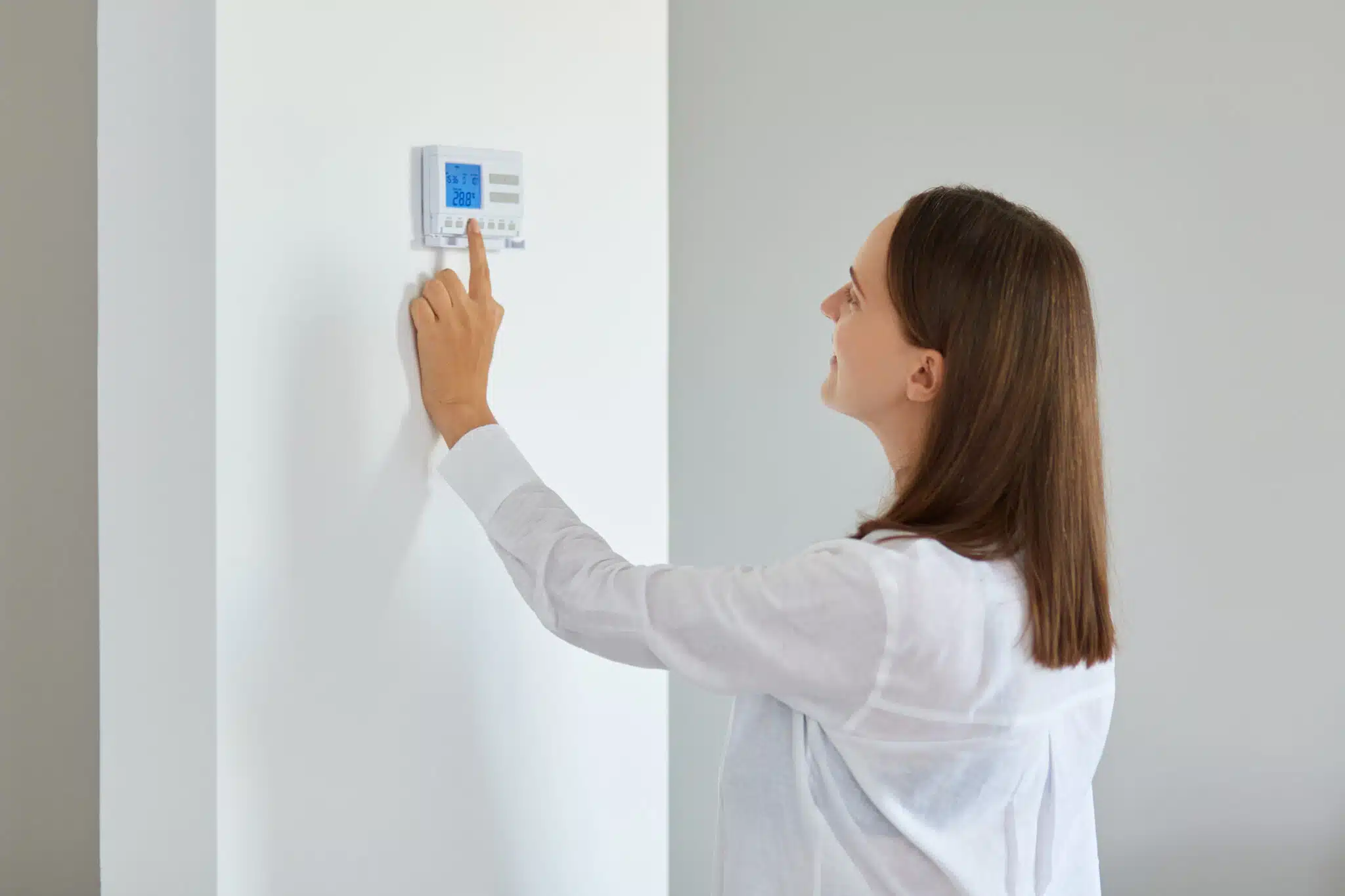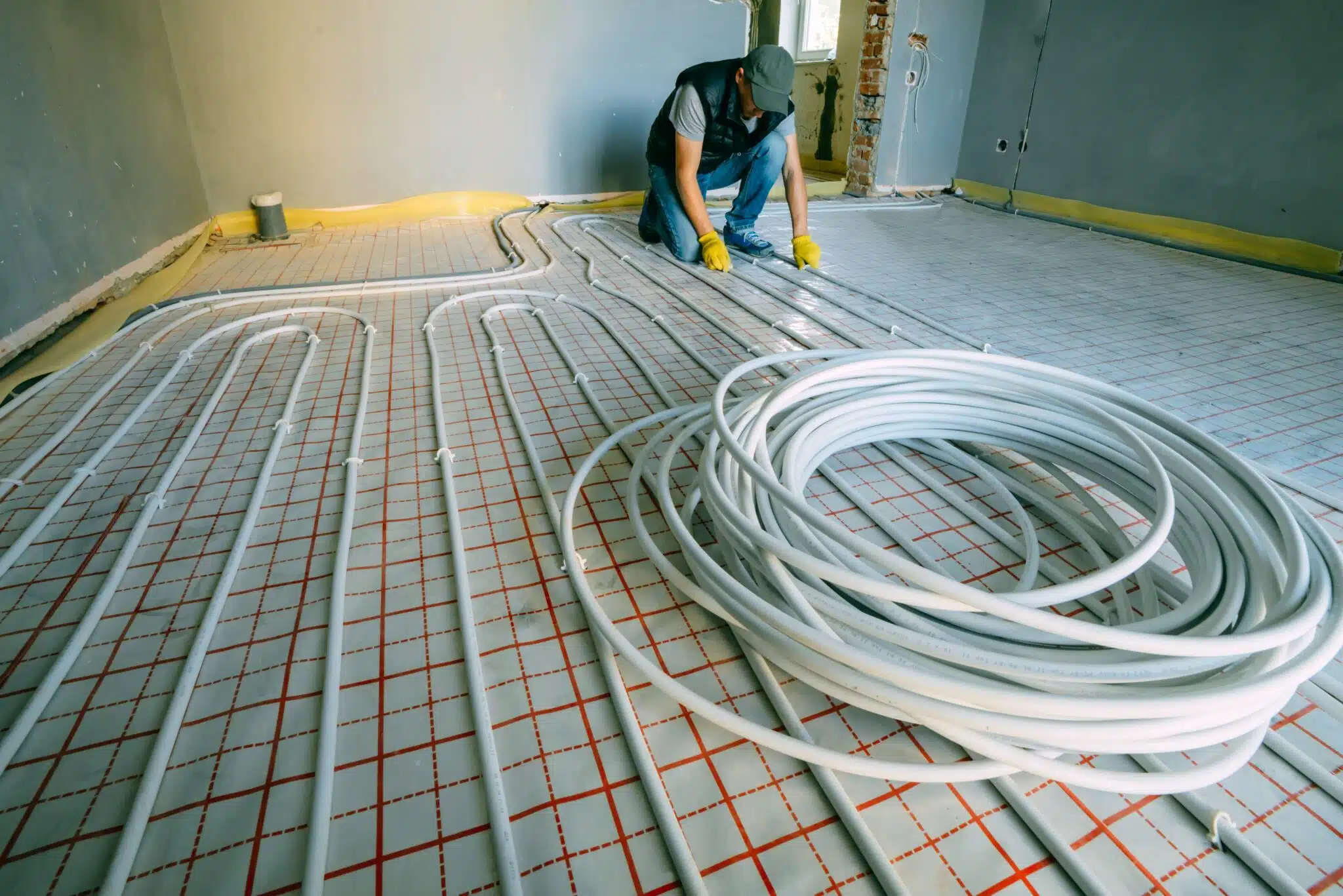Why choose radiant floor heating over traditional options? This modernized system, inspired by ancient Roman ingenuity, provides consistent warmth that rises gently from the floor. Not only does it eliminate uncomfortable drafts and cold spots, but it also reduces energy costs by working more efficiently at lower thermostat settings.
Homeowners increasingly prefer radiant floor heating for its energy savings, silent operation, and improved indoor air quality—a practical, comfortable, and eco-friendly choice.
How Radiant Floor Heating Works
Radiant floor heating works by circulating warm water or electricity through hidden pipes or mats installed beneath the floor’s surface. This design offers an even, soothing warmth that starts at the floor and gently radiates upward, keeping every corner of the room at a consistent temperature. Unlike conventional forced-air systems that create drafts and stir up dust, radiant heating provides a silent and clean alternative, maintaining better air quality and reducing the spread of allergens.
One of the most notable advantages of radiant floor heating is its energy efficiency. By heating the room from the floor up, you experience a cozy warmth throughout the entire space without relying on high thermostat settings.
As a result, homeowners often find they can keep their homes comfortable while using less energy, which translates to lower heating costs. This efficiency not only reduces utility bills but also lessens the environmental impact, making radiant floor heating an eco-friendly choice.
Beyond the practical benefits, radiant floor heating adds a luxurious feel to any home. Imagine stepping onto warm floors on a chilly morning or feeling even, comforting warmth as you walk barefoot. For those considering renovations or building new homes, radiant floor heating offers a modern, effective solution that combines luxury with functionality—ideal for those who value both comfort and efficiency.
Benefits of Radiant Floor Heating Over Traditional Heating
Radiant floor heating stands out as a premium choice for home heating, outperforming traditional forced-air systems in key areas of comfort, efficiency, and indoor air quality. Here’s why radiant floor heating has become a favorite among homeowners seeking a quiet, consistent, and efficient heating solution:
-
Unmatched Comfort with Even Heat Distribution
Radiant floor heating delivers warmth directly from the floor up, eliminating the uneven temperatures and cold spots common with forced-air systems. While forced-air heating pushes warm air through vents, creating drafts and leading to temperature fluctuations, radiant heating maintains an even, stable warmth throughout the entire room. This consistency enhances comfort, especially in rooms with high ceilings, as the heat remains concentrated where it’s needed most—at ground level.
-
Superior Energy Efficiency and Cost Savings
Radiant floor heating operates at lower temperatures than forced air yet achieves effective warmth. By bypassing the need for ductwork—which can lose up to 30% of heated air through leaks in older homes—radiant systems retain nearly all the energy they produce. This efficiency can reduce energy bills by 15-20% over traditional heating methods, making radiant floor heating a more sustainable, cost-effective option in the long term.
-
Whisper-Quiet Operation for Enhanced Peace
Radiant heating systems provide a silent warmth, unlike forced-air systems, which rely on noisy fans, vents, and blowers that cycle on and off throughout the day. The absence of mechanical noise makes radiant floor heating especially suited for bedrooms, bathrooms, and spaces where a quiet atmosphere is valued. This quality adds a layer of tranquility to the home environment, setting radiant heating apart as a premium option for sound-sensitive areas.
-
Cleaner, Healthier Indoor Air Quality
Forced-air systems often circulate dust, pollen, and allergens through ducts and vents, negatively impacting indoor air quality. Radiant floor heating, on the other hand, provides warmth without moving air, reducing airborne particles and allergens significantly. This makes radiant heating a more hygienic choice, particularly beneficial for allergy sufferers and those sensitive to dust and contaminants in the air.
By combining comfort, efficiency, quiet operation, and improved air quality, radiant floor heating provides a superior heating experience that traditional systems can’t match. Homeowners are increasingly choosing this innovative solution to create an eco-friendly, clean, and comfortably warm environment year-round.
Types of Radiant Floor Heating Systems
Two primary radiant heating systems—hydronic and electric—offer exceptional warmth, efficiency, and comfort, tailored to different home setups and needs. Both options ensure even heat distribution, silent operation, and energy savings, making them ideal for modern homes.
Hydronic Radiant Heating Systems
Hydronic systems circulate heated water through durable PEX tubing beneath the flooring. This water-based system is efficient over large areas, ideal for entire homes or expansive spaces. Hydronic systems work best with surfaces like tile, stone, or concrete, which effectively transfer and retain heat. Though installation requires more planning and professional expertise, hydronic systems significantly reduce heating costs, as water retains heat effectively, needing less energy to sustain warmth. These systems not only offer long-term savings but also provide steady, all-encompassing warmth—especially valuable in colder months.
Electric Radiant Heating Systems
Electric systems are perfect for smaller spaces like bathrooms or kitchens, where quick, targeted warmth is needed. Heating cables or mats installed under the flooring provide a rapid response, making electric radiant heating a practical choice for single-room applications or selective use. Installation is relatively easy, often ideal for retrofitting projects in already-built homes. However, electric radiant heating may be less economical for large areas due to electricity costs, so it’s generally best for specific rooms that require quick and efficient heating.
Flexible Installation Options: Wet and Dry
Both hydronic and electric systems offer flexible installation with wet and dry options. Wet installations embed tubing or cables within a concrete layer, which is ideal for new construction as it provides thermal mass that retains heat longer. Dry installations, on the other hand, involve placing the tubing within subfloor layers, keeping height changes minimal and making them perfect for retrofitting projects. This flexibility means that homeowners can choose the right setup based on room layout, construction phase, and floor type.
Hydronic systems bring sustained, efficient heating to large spaces, while electric systems are ideal for specific, immediate warmth in smaller rooms. Both types provide quiet, allergy-friendly warmth that enhances indoor air quality, reduces energy consumption, and offers a cozy, efficient alternative to traditional heating methods.

Energy Efficiency and Cost Savings
Radiant floor heating offers substantial energy efficiency and cost savings, which makes it an attractive choice for homes in Reading, PA, where cold winters often mean higher heating needs. With its ability to deliver warmth directly through the floor, this system keeps rooms consistently comfortable without the higher thermostat settings required by forced-air systems. Here’s how radiant floor heating provides both energy savings and cost efficiency, ideal for the climate and heating demands of homes in Reading:
Efficient Low-Temperature Heating
Unlike traditional systems that need high temperatures to combat cold air, radiant floor heating operates effectively at lower settings, reducing energy consumption. Since it heats surfaces directly, homeowners in Reading can lower their thermostat by a few degrees and still feel comfortable, reducing energy use by up to 20% annually. This efficiency is especially valuable during Pennsylvania’s colder months.
No Duct-Related Heat Loss
Forced-air heating can lose up to 30% of generated heat through ducts, especially if they are older or not properly sealed. Radiant floor heating eliminates this issue by heating directly through the floor surface, which keeps warmth within the room without losing energy to ductwork. For Reading homes, which may have older duct systems, this direct heat delivery translates to significant energy savings and lower monthly bills.
Zone Heating for Greater Control
Radiant heating systems allow homeowners to control temperatures by room, a particularly cost-effective feature for Reading residences. This zoning means that high-traffic areas, like living rooms and kitchens, can stay warm without heating unused spaces, creating additional savings. By using programmable thermostats, Reading residents can adjust their heating based on room usage patterns, avoiding unnecessary energy use and saving up to 10% more on heating bills.
Long-Term Cost Efficiency
While installing radiant heating may involve a higher initial cost, especially for hydronic systems, the savings over time in a place like Reading, where winters are lengthy, often offset the investment. Hydronic systems offer extended cost efficiency for large areas, while electric systems are effective for smaller, high-use spaces, like bathrooms, delivering rapid warmth when needed most. These systems provide a sustainable heating alternative that maximizes comfort and minimizes energy waste.
For Reading, PA homeowners, radiant floor heating is an excellent solution for staying warm efficiently and cutting down on heating expenses through Pennsylvania’s long winters.
Ideal Rooms for Radiant Floor Heating
Radiant floor heating is particularly effective in spaces where comfort and warmth are key, like bathrooms, kitchens, and living rooms. Here’s why these areas are ideal, along with the advantages of using electric systems for single-room installations and retrofits:
Bathrooms
Radiant heating provides a warm surface in bathrooms, where tile floors can feel cold, especially in the winter. The direct heat from the floor keeps the entire room cozy and makes stepping out of the shower more comfortable. Electric radiant systems are particularly well-suited for bathrooms, as they heat quickly and are easy to install in small spaces.
Kitchens
With tile or laminate floors and high traffic, kitchens benefit from radiant heating’s even warmth. Radiant systems also open up wall space, which is valuable in kitchens with limited room for radiators. Electric systems are excellent for single-room kitchen installations, as they offer fast heating and independent temperature control, enhancing flexibility and comfort.
Living Rooms
For larger living spaces, radiant floor heating creates a cozy, quiet environment without vents or ducts. Hydronic systems are ideal here, providing consistent heat across wide areas and lower operating costs over time.
This targeted approach makes radiant floor heating a practical, luxurious option for enhancing comfort in high-use spaces throughout the home.
Common Materials and Flooring Options for Radiant Heating
Choosing the right flooring is essential to maximize the benefits of radiant heating. Here are three top-performing materials:
- Tile: Tile, especially ceramic or stone, is highly conductive, making it ideal for radiant heating. It quickly absorbs and distributes warmth evenly, keeping rooms cozy even after the system is off. The tile also stands up well to moisture, making it perfect for bathrooms and kitchens.
- Engineered Wood: Engineered wood is more stable than solid wood under temperature changes, making it compatible with radiant heating. Thinner planks allow better heat conduction, and species like oak and walnut enhance durability. Always confirm that the chosen product is radiant heat-approved to ensure safe use.
- Luxury Vinyl: Luxury vinyl, when heat-rated, is a budget-friendly option that warms effectively in smaller spaces. Though less conductive than tile, it works well in retrofitted rooms like bedrooms or living rooms.
Tile remains the best choice for even heat, but engineered wood and vinyl are great alternatives, enhancing radiant heating’s efficiency and comfort.
Installation Considerations and Costs
Installing radiant floor heating requires careful planning and cost consideration, especially when choosing between hydronic and electric systems.
Installation Costs and Challenges
Electric radiant systems are generally easier to install and cost around 8–15 per square foot, making them suitable for smaller spaces or single-room use. Hydronic systems, ideal for larger areas, cost around 6–12 per square foot but require more complex installation, including boilers and tubing, which can raise costs and installation time.
Retrofit Requirements
Retrofitting radiant heating in existing homes can be challenging, particularly for hydronic systems, which may need floor height adjustments or concrete embedding. Electric systems are easier to retrofit, as they can often be laid under various flooring types without major structural changes.
Professional Installation for Hydronic Systems
Due to their complexity, hydronic systems benefit from professional installation, especially in larger spaces. A skilled installer ensures proper spacing and tubing, crucial for efficiency and even heating.

Maintenance and Longevity of Radiant Floor Heating
Radiant floor heating systems are not only efficient and comfortable but also built to last, with minimal maintenance required over their long lifespan. Here’s how this heating solution stands out for durability, low upkeep, and increased home value:
Minimal Maintenance Requirements
One of the key benefits of radiant floor heating is its low maintenance, especially compared to forced-air systems that require regular filter changes and duct cleanings. Electric radiant systems require virtually no upkeep once installed. Hydronic systems, however, benefit from seasonal check-ups to keep the boiler and tubing in optimal condition, especially during colder months. These periodic inspections help maintain efficiency, catch minor issues early, and ensure even heating throughout the home.
Extended Lifespan and Enhanced Resale Value
Radiant floor heating is an investment in both comfort and home value. With a lifespan of up to 30 years, these systems provide steady warmth and significant energy savings year after year. For potential buyers, radiant heating is a premium feature, often enhancing a home’s resale appeal as it combines luxury and sustainability. Hydronic systems, in particular, are highly valued for larger spaces, where their efficiency over time translates to lower heating costs and consistent comfort. Homebuyers increasingly look for features like radiant heating, which offers both comfort and energy efficiency—making it a solid addition to any home.
In summary, radiant floor heating offers durability, easy maintenance, and substantial resale value, making it a smart, long-term investment for homeowners seeking comfort and sustainability.
FAQ
-
Is radiant floor heating energy-efficient?
Yes, radiant floor heating is highly energy-efficient. It works by warming the floor directly, allowing for lower thermostat settings while maintaining comfort. This can reduce energy usage by 15-20% compared to forced-air systems, which lose heat through ducts.
-
How does radiant floor heating compare with forced air?
Radiant floor heating offers several advantages over forced-air systems. It provides even, consistent warmth from the floor up without creating drafts or circulating dust, making it a quieter, allergy-friendly option. Forced-air systems can create hot and cold spots and often require higher thermostat settings, resulting in higher energy consumption.
-
Can it be installed under any floor type?
Radiant floor heating is compatible with many flooring types, including tile, engineered wood, and vinyl. Tile is the most effective as it conducts heat well, while engineered wood and vinyl work well with electric systems when heat-rated. Carpet is generally not recommended as it insulates against heat, reducing efficiency.
-
What’s the expected installation cost?
Installation costs vary by system type and area size. Electric systems typically range from 8 to 15 per square foot, making them ideal for single-room applications, while hydronic systems cost around 6 to 12 per square foot, offering better value for larger areas.
-
Does it require much maintenance?
Radiant floor heating is low-maintenance. Electric systems require little to no upkeep after installation. Hydronic systems benefit from seasonal check-ups to ensure the boiler and tubing work efficiently, which can extend their lifespan up to 30 years.
Radiant floor heating is a lasting investment in comfort, efficiency, and home value. With its quiet operation, even heat distribution, and minimal maintenance, it’s the perfect solution for consistent warmth.
One Hour Heating & Air Conditioning of Lancaster provides professional installation to ensure you get the maximum benefit from your radiant heating system. Contact them today to elevate your home’s comfort and energy efficiency.





